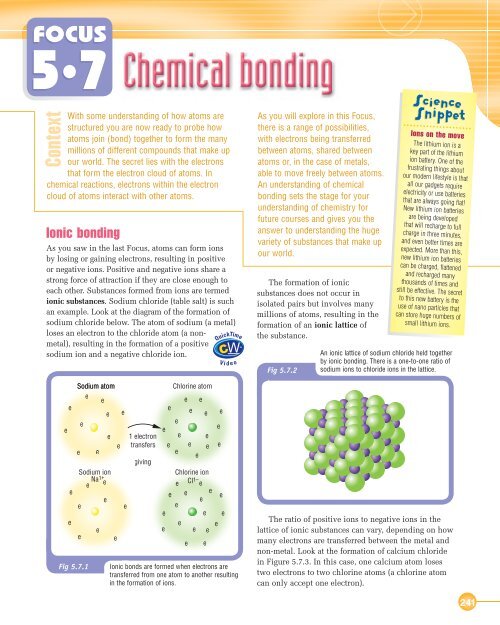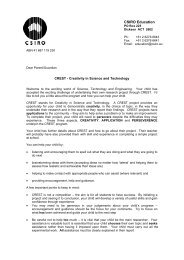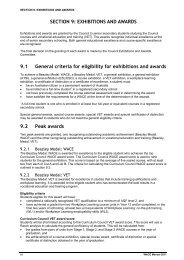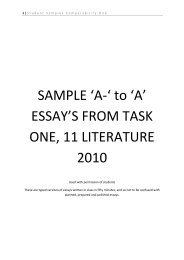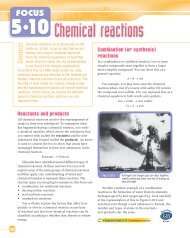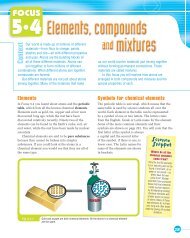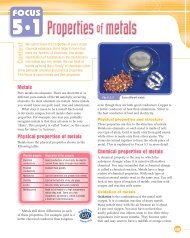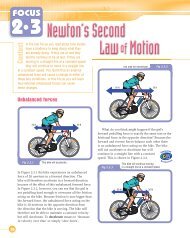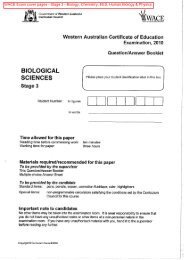Focus 5.7 Chemical Bonding
Focus 5.7 Chemical Bonding
Focus 5.7 Chemical Bonding
Create successful ePaper yourself
Turn your PDF publications into a flip-book with our unique Google optimized e-Paper software.
FOCUS<strong>5.7</strong>With some understanding of how atoms arestructured you are now ready to probe howatoms join (bond) together to form the manymillions of different compounds that make upour world. The secret lies with the electronsthat form the electron cloud of atoms. Inchemical reactions, electrons within the electroncloud of atoms interact with other atoms.ContextIonic bondingAs you saw in the last <strong>Focus</strong>, atoms can form ionsby losing or gaining electrons, resulting in positiveor negative ions. Positive and negative ions share astrong force of attraction if they are close enough toeach other. Substances formed from ions are termedionic substances. Sodium chloride (table salt) is suchan example. Look at the diagram of the formation ofsodium chloride below. The atom of sodium (a metal)loses an electron to the chloride atom (a nonmetal),resulting in the formation of a positivesodium ion and a negative chloride ion. Fig <strong>5.7</strong>.1 Ionic bonds are formed when electrons aretransferred from one atom to another resultingin the formation of ions.As you will explore in this <strong>Focus</strong>,there is a range of possibilities,with electrons being transferredbetween atoms, shared betweenatoms or, in the case of metals,able to move freely between atoms.An understanding of chemicalbonding sets the stage for yourunderstanding of chemistry forfuture courses and gives you theanswer to understanding the hugevariety of substances that make upour world.The formation of ionicsubstances does not occur inisolated pairs but involves manymillions of atoms, resulting in theformation of an ionic lattice ofthe substance.Fig <strong>5.7</strong>.2Ions on the moveThe lithium ion is akey part of the lithiumion battery. One of thefrustrating things aboutour modern lifestyle is thatall our gadgets requireelectricity or use batteriesthat are always going flat!New lithium ion batteriesare being developedthat will recharge to fullcharge in three minutes,and even better times areexpected. More than this,new lithium ion batteriescan be charged, flattenedand recharged manythousands of times andstill be effective. The secretto this new battery is theuse of nano particles thatcan store huge numbers ofsmall lithium ions.An ionic lattice of sodium chloride held togetherby ionic bonding. There is a one-to-one ratio ofsodium ions to chloride ions in the lattice.The ratio of positive ions to negative ions in thelattice of ionic substances can vary, depending on howmany electrons are transferred between the metal andnon-metal. Look at the formation of calcium chloridein Figure <strong>5.7</strong>.3. In this case, one calcium atom losestwo electrons to two chlorine atoms (a chlorine atomcan only accept one electron). 241
Covalent molecules can be small and simple, suchas the ones we use every day, shown in Figure <strong>5.7</strong>.6. Covalent molecules can be simple andconsist of small numbers of atoms.Fig <strong>5.7</strong>.6You might have noticed that the atoms involvedin covalent molecules are all non-metals. Covalentbonding is the method by which non-metals combineor by which atoms of the same kind (for examplenitrogen, N 2 , and oxygen, O 2 ) join to form molecules.Covalent molecules can be large and complex, suchas in plastics, paints and other materials we use on adaily basis. Our own bodies are composed of thousandsof different covalent molecules, ranging from smallsimple molecules to large complex molecules.Unlike ionic substances, covalent molecules donot have any charged particles and as a result they arepoor conductors of electricity aseither solids or liquids.Covalent networksThe covalent substances you haveexplored in the previous sectioncontain individual molecules ofvarious sizes. Certain substances,such as carbon and silicon, formgiant networks of covalentlybonded atoms. A commonexample of this is diamond,in which carbon atoms forma three-dimensional networkof carbon atoms. Anothercovalent network is silicondioxide (silica), which consistsof a network of silicon andoxygen atoms. Silica is a majorcomponent of sand.The hardestsubstanceDiamonds are virtuallyindestructible—in fact,their name comes from theGreek word adamas, whichmeans indestructible. Theyare the hardest substanceon Earth. Formed deepwithin the surface of theEarth under extreme heatand pressure, they areonly brought to the surfaceby volcanic action. Mostdiamonds are between 1and 3 billion years old andare the only gemstoneswhich are composed ofjust one chemical element,carbon.<strong>5.7</strong>FOCUSFig <strong>5.7</strong>.7Your body contains hundreds of differentcovalent molecules, such as this vitamin Cmolecule and the insulin molecule.Fig <strong>5.7</strong>.8Diamond is made of carbon atoms joined in ahuge network of interlinked carbon atoms.Because there are no individual molecules incovalent networks, they have very high meltingpoints, such as diamond, which melts at just over4000°C. They do not contain charged particles and, asa result, are also poor conductors of electricity.Metallic bondingWhen you think about metals, what are some ofthe special properties that come to mind? Is it theirability to conduct electricity and heat so well? Or isit their ability to be flattened, bent and even stretched243
<strong>Chemical</strong> bonding>>>into sheets and wires? Either way, the specialproperties can be related to the way the metallicatoms are bonded.In metals, the atoms are packed together in alattice, with the special difference that the electronsof each atom that are furthermost from the nucleus arefree to move between the atoms of the lattice.This free movement of electrons within the metallattice accounts for the electrical conductivity ofmetals. The mobility of the electrons also meansthat the force of attraction between the electronsand nucleus can also move. So metals can be bent(they are malleable) and stretched (they are ductile)and still maintain strong forces of attraction withinthe network. The strong forces of attraction withinthe lattice also result in metals having highmelting and boiling points.Homework book <strong>5.7</strong> <strong>Chemical</strong> bondingPrac 1p. 245free-movingelectron betweenthe atomsFig <strong>5.7</strong>.9<strong>5.7</strong>FOCUSUse your bookmetal atomIn a metal lattice, the positive ions aresurrounded by electrons that are free tomove within the lattice.[ Questions ]Ionic bonding1 Explain how ionic bonds are formed.2 Describe how the ionic bond between the sodium andthe chlorine atoms forms.3 Describe, in terms of the ionic bond, why ionic latticesare so strong.Covalent bonding4 Explain how a covalent bond forms.Covalent molecules5 Give three examples of substances that form covalentmolecules.Covalent networks6 Describe the main structural difference between acovalent network substance and a covalent molecularsubstance.7 Covalent substances such as diamond are very hard.Use Figure <strong>5.7</strong>.8 to explain this observation.Metallic bonding8 Describe how the atoms are arranged in a metal.9 Why are metals such good conductors of electricity?10 What do the terms ‘malleable’ and ‘ductile’ mean?Use your head11 What type of bonds would you expect to find betweenthe following atoms. Explain your answers.a An atom of potassium (a metal of atomic number19) and an atom of fluorine (a non-metal of atomicnumber 9) to form part of a lattice of potassiumfluoride.b Two atoms of chlorine to form a chlorine molecule(Cl 2 ).12 The substance potassium chloride exists as an ioniclattice consisting of one atom of potassium to oneatom of chlorine.a Draw a diagram which shows how a section ofionic lattice would look.b Describe how the metal atom of potassium wouldinteract with the non-metal atom of chlorine to formpart of the ionic lattice of potassium chloride.c What type of bonding is this?d The melting point of potassium chloride is 776°C.Explain in terms of the structure why it is so high.13 Both sugar (C 12 H 22 O 11 ) and silicon carbide (SiC) aresubstances whose atoms are joined together bycovalent bonds. Sugar is found as molecules whilesilicon carbide is a network substance.a One of the substances has a melting point of2700°C while the other has a melting point of185°C. Identify the correct melting point for eachsubstance and use the structure shown in Figure<strong>5.7</strong>.10 to explain your decision.>>244
14 Gold leaf is pure gold which has been rolled intovery thin sheets and can then be pressed onto avariety of surfaces to decorate them. Gold leaf can beas thin as 0.0001 mm. The atoms in gold are joinedby ‘metallic bonds’. Describe the special propertiesof metallic bonds which allow the gold to be rolled intosuch thin sheets.<strong>5.7</strong>FOCUSInvestigating questions Sugar is a covalent molecule, whilesilicon carbide is a covalent network.Fig <strong>5.7</strong>.10b One of these substances is used to manufactureabrasive discs used for grinding concrete, bricks andsteel. Which substance do you think it is? Explain thisproperty in terms of the structure of the material.15 Diamond and graphite are both forms of carbon inwhich the atoms are joined by covalent bonds.a Describe the different properties of these twosubstances.b Explain the different properties of graphite andcarbon in relation to their different structures.c What is the name given to different forms of thesame element? What are some other examplesof this?d Use the structure of these two substances toexplain why graphite is used as the ‘lead’ in leadpencils while industrial diamonds are often usedin the leading edge of drilling bits that drill throughsolid rock.16 Pure iron (called wrought iron) is quite soft andmalleable and is often used to make decorativefencing and verandah features which involve twistingand bending the iron into a variety of shapes. Ifsmall amounts of carbon are added to pure iron, theproperties change and the iron becomes hard andbrittle. Explain, using diagrams, why carbon changesthe properties of the iron.<strong>5.7</strong>FOCUSPrac 1<strong>Focus</strong> <strong>5.7</strong>[ Practical activity ]Exploring the properties of chemical bondingPurposeTo explore the chemical bonding in ionic solids,covalent molecules, covalent network andmetallic substances by examining their physicalproperties.RequirementsSamples of an ionic solid (sodium chloride), covalentmolecular substance (naphthalene), covalent networksubstance (silicon dioxide or clean sand) and a metallicsubstance (iron filings and piece of iron), four spatulas,four crucibles, bench protector, stirring rod, four test tubes,pipeclay triangle, evaporating basin, conductivity apparatus(as used in Prac 1 in <strong>Focus</strong> 5.6) and power pack.Safety note: Take great care when heating these substances in thecrucible. This part of the activity is to be done by the teacher only.Naphthalene is flammable and extreme care should be taken whenheating it in an open flame. It should be heated only with a flamein a fume cupboard.When smelling substances, hold the material up to yournose and waft the odour towards your nose.>>245
<strong>Chemical</strong> bonding>>>Procedure1 Make a copy of the table below in your notes.SubstanceSodium chlorideNaClNaphthaleneC 6 H 4 C 12Silicon dioxideSiO 2 unitsType of bonding Ionic Covalent molecular Covalent network MetallicOdourHardnessSolid conductivitySolubilitySolutions conductivityEase of meltingMolten conductivityIronFe2 Odour test—place a couple of spatula tips of eachsubstance into the four crucibles. Smell each of thematerials in turn (by wafting the odour towards yournose) and record any strong odours in your results table.3 Hardness test—place a couple of grains of each ofthe substances onto your bench protector. Test to seehow hard each of the materials is by trying to grind thematerial into the bench protector using the end of apencil or stirring rod. If the material can be ground orsquashed record it as ‘soft’. If not, then record itas ‘hard’.4 Solid conductivity test—use the conductivity apparatusto test the conductivity of each of the substances. Dothis by lowering the electrodes into crucibles of each ofthe substances (see the practical activity in <strong>Focus</strong> 5.6for how to set up and use the conductivity apparatus).Record your results.5 Solubility test—check to see which of the substanceswill dissolve by adding a small amount of eachsubstance into a test tube. Add a small amount of waterand use the stirring rod to try to dissolve the material.Record your observations.6 Solutions conductivity test—for those substances thatdissolve, test the conductivity by pouring the solutioninto a crucible and test using the conductivity apparatus.Record your observations.7 Melting and conductivity test—this is to be carriedout by your teacher. They will place a small amount ofeach of the substances into a crucible and heat thesubstances in turn. Record your observations. Whileeach substance is molten, your teacher will measure theconductivity using the conductivity apparatus. Recordyour results.Questions1 Which of the substances had a strong odour? Giventhat for you to smell a substance, the material has todissolve in the mucous lining of your nose, what doesthis tell you about the structure of the material(s) withthe odour?2 Which of the materials was the softest? What was thetype of bonding in this substance? Explain your answerin terms of the bonding involved.3 Which of the substances conducted electric currentwhen solid? For a substance to carry an electric currentit must have a charge carrier such as electrons or ions.Explain your observations.4 Which of the substances was the easiest to melt, andwhich the hardest to melt? Explain your observations interms of the bonding involved.5 Which of the materials conducted a current whenmolten? Explain your observations in terms of thebonding involved.246


